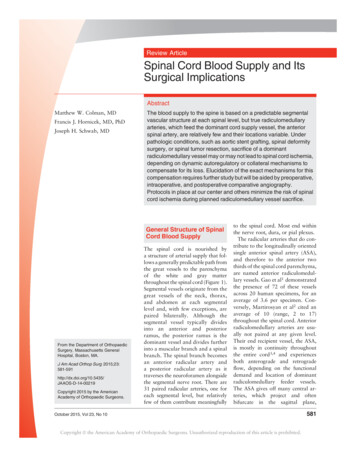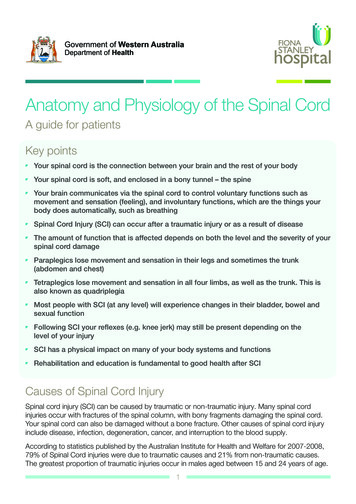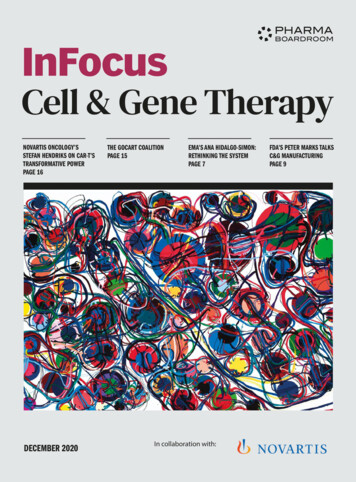
Transcription
Understanding Spinal Cord Injury, Part 2—Recovery and RehabilitationJanuary 2015This fact sheet is the second in atwo-part series in understandingspinal cord injury (SCI). Partone, The Body Before and AfterInjuryInjury, contains terms andinformation that are discussed inthis fact sheet.SCI Fact SheetCan paralysis caused by spinal cord injury be reversed?Everyone wants to know if there is a “cure” for spinal cord injury (SCI). There continues to besignificant progress made toward this goal, but, despite any claim that there is a cure, there iscurrently no proven way to reverse paralysis.Will I gain any improvements?There are three areas for potential improvement after SCI.1.Severity of Injury: At the time of your injury, your injury is graded as either complete orincomplete. Your grade my change. For example, you may be first classified as AIS C andimprove to AIS D.2.Levels of injury: At the time of your injury, you are diagnosed with a neurological level of injury.You may regain levels of injury over time. For example, you may be first classified with a C4level of injury and improve to a C5 level. This means you gain control of more musclemovement.3.Functional abilities: These are the activities you are capable of doing as you regain musclestrength and learn to use those muscles after injury. Pushing a wheelchair is one example.How much improvement will I gain?There is almost always hope for at least some improvement after SCI, but there are no guarantees.You have to wait to see what happens in the months after your injury. Here are a few rules of thumb. People with a complete injury often regain 1 or 2 levels of injury. This means you often regaincontrol of 1 or 2 levels of muscle movement. People with an incomplete injury are more likely than people with a complete injury to regaincontrol of more muscle movement, but there is no way to know how much, if any, will return. As long as you are seeing some improvement, like regaining muscle movement, your chancesfor improvement are better. The longer you go without seeing improvement, your chances for improvement are lower.What is Rehabilitation?The Spinal Cord Injury ModelSystem is sponsored by theNational Institute on Disabilityand Rehabilitation Research,Office of Special Educationand Rehabilitative Services,U.S. Department of m-centers formore information).Your body drastically changes after paralysis. You have medical needs that must be managed. Youlose muscle movement and feeling. Plus, you probably have muscle weakness and fatigue afterinjury in the muscles that you can move. Simply put, you may not be able to do some daily livingactivities in the same way you did before your injury.Rehabilitation (rehab) is a medical service that can help you reach your full potential after injury.Every injury is different, so rehab is tailored to each person’s needs. Skilled specialists provide thenecessary services to help you make the most of your abilities. Physiatrists (pronounced fiz-EYE-ah-trists) are rehab doctors who lead your treatment team andmanage your medical care. Psychologists develop and apply treatment strategies in counseling to help you through youradjustment to life after injury. Nurses usually carry out orders from your doctor, and they often provide the essential educationyou need on how to manage issues like bowel and bladder management.
Physical therapists use a wide variety of techniques to help you regain the strength and stamina to maximize your physical abilities. Occupational therapists use a wide variety of techniques to help you increase and maintain your independence in carrying out yourdaily living activities. Speech-language pathologists (speech therapists) treat any issues that may develop with swallowing or speaking. Social workers link you and your family to information and resources that help ease your transition from in-patient rehabilitation tohome and community living.What is my role in rehab?You have to put all of your effort into rehab to get the most out of it. You will work with your rehab team to set goals that are a realisticexpectation of what you should be able to do with the muscle movement you have after injury. To reach your goals, you have to work ashard as you can with your rehab team to help you get stronger and learn the skills you need to manage daily activities and beindependent. Some common goals include using a wheelchair, transferring, driving a car, bathing, eating, and dressing.Also, learn as much as you can about how to take care of yourself. Learn how to manage your daily concerns, such as bladder andbowel. Learn how to best prevent health problems like pressure ulcers, urinary tract infections, and pneumonia. Learn what you shoulddo if you develop pain, autonomic dysreflexia, depression, or other medical problems.What advice can be offered from other people with SCI about rehab?People who have been injured and gone through rehab understand what you and your family are experiencing. They have been whereyou are now, and they can offer some valuable suggestions to help guide you during rehab. They offer the following advice. Trust your rehab team. Rehab professionals are very knowledgeable, and it is in your best interest to follow their advice in settingand reaching your goals. They can also advise you on how to best avoid many of the common setbacks people experience duringrehab. For example, pressure ulcers can severely limit your ability to participate in rehab, but most pressure ulcers can beprevented if you do your weight shifts (also known as a pressure relief) as directed by your rehab team. Remember that who you are does not change after injury. You have the love and support of your family, friends, and others in yourcommunity. They can be a valuable support network in helping you reach your goals. Approach rehab with a balanced mindset. Everyone hopes they will regain all of their lost movement and feeling. However, thereality is that people are more likely to regain some, but not all, movement and feeling. This makes it very important that youparticipate in rehab to learn the skills necessary to have the healthiest and happiest life after SCI. Attending education classes willhelp you learn about SCI And how to take care of yourself. If you do regain everything, you have lost nothing in the process oflearning those skills. If you do not regain everything, you will have the valuable knowledge and skills you need for everyday living. Be patient. SCI is a traumatic event that tears your life apart in an instant, and it takes time to rebuild your life after injury. Yourbody will need time to heal from the trauma of your injury. You will need time to regain the strength and stamina to reach yourgoals. However, you can do it in time. You will have bad days. It is only natural to feel sad, angry, or afraid at times. There may be times when it is hard to imagine howyou can ever be happy after injury. However, most people do find happiness over time as they begin to realize they can live anactive, healthy life. Take advantage of peer support. Your rehab team can likely arrange for you to talk with others who have SCI. They have beenwhere you are and learned how to manage day-to-day activities. They can be a valuable source of information. There are alsosome online support networks. Here are a couple of recommended sites that have a focus in peer support. www.spinalcord.org provides information and resources to meet the needs of people with SCI and their families and friends. www.facingdisability.com is designed to provide Internet-based information and support for people with SCI and their families.The website has more than 1,000 videos of family members answering real-life questions about how they cope with SCI.Ask questions. You will probably have many questions. If you have questions, ask your rehab team. Most questions can beanswered, but there may be some questions that cannot be answered. When it comes to regaining movement after injury, forexample, sometimes it just takes time to see what happens.SCI and Understanding Part 2: Recovery and Rehabilitation
What are my functional goals?There is a chart on the following pages that outlines common functional goals. These goals are daily activities that most people canmanage with the control of muscle movement that they have with a complete injury. You may be able to do additional activities if youhave an incomplete injury or if you regain control of more muscle movement. You will work with your rehab team to set your goals andfind ways you can reach your goals. Below is a step-by-step guide to using the chart.1.Find your level of injury in the Level of Injury column.2.The Physical Abilities column shows what muscle movement is common for anyone with a complete injury at that level.3.The Functional Goals column outlines how people might manage typical daily activities based at that level of injury.4.The Equipment Used column suggests various equipment options that might be useful in accomplishing those functionalgoals.Level ofInjuryC1–C3C3–C4Physical AbilitiesFunctional GoalsC3—Limited movement of headand neck.Breathing: Depends on ventilator forbreathing.Usually has head and neckcontrol.At C4 level, may shrug shoulders.Communication: Talking is sometimesdifficult, very limited, or impossible. If theability to talk is limited, communication can beaccomplished independently, with adaptiveequipment.Daily tasks: Full assistance from caregiverfor turning in bed, transfers, and all self-care(including bowel and bladder management).Assistive technology can allow forindependence in such tasks as reading abook or newspaper, using a telephone, andoperating lights and appliances.Mobility: Can operate an electric wheelchairby using a head control, mouth stick, sip andpuff, or chin control. Can also operate apower tilt wheelchair also for independentpressure relief.Breathing: May initially require a ventilatorfor breathing; usually adjusts to breathing fulltime without ventilator assistance.Communication: Normal.Daily Tasks: Individual requires fullassistance from a caregiver for turning in bed,transfers, and all self-care (including boweland bladder management). Individual may beable to use adaptive equipment to eatindependently. May also be able to operatean adjustable bed and perform other tasks,such as painting, writing, typing, and using atelephone with assistive technology.Mobility: Can operate a power wheelchair byusing head control, a mouth stick, sip andpuff, or chin control. Power tilt function onwheelchair allows for independence withpressure relief.SCI and Understanding Part 2: Recovery and RehabilitationEquipment UsedSuction equipment to clear secretions,two ventilators with backup generatorand batteryMouth stick and assistive technology(e.g., computer, communication board)for speech or typingMouth stick, environmental control unit(ECU)Power or manual lift, electric or semielectric hospital bed, power wheelchairwith pressure-relieving cushionCough-assist deviceEating: Sandwich holder on agooseneck, feeder, long straw forliquidsOther Activities: ECU for operatingbed (e.g., head or voice activated,mouth stick controller), hands-freedevices, mouth stick for typing, etc.Power or manual lift, electric or semielectric hospital bed, power wheelchairwith pressure-relieving cushion
Level ofInjuryC5C6Physical AbilitiesTypically has head and neckcontrol, can shrug shoulders, andhas some shoulder control. Canbend elbows and turn palms faceup.Has movement in head, neck,shoulders, arms, and wrists. Canshrug shoulders, bend elbows,turn palms up and down, andextend wrists.Functional GoalsDaily Tasks: Individual can be independentwith eating and grooming (e.g., face washing,oral care, shaving, make-up application) aftersetup from caregiver, with specializedequipment. Individuals will require totalassistance from caregiver for bed mobility,transfers, and all other self-care. May be ableto assist caregiver with upper body dressingand some bathing, with adaptive equipment.Health Care: Individual will requireassistance from caregiver for cough assist.Can perform pressure relief with power tilt inpower wheelchair.Mobility: May have strength to push amanual wheelchair for short distances overlevel surfaces; however, a power wheelchairwith hand controls will be required for dailyactivities. At this level, the individual may beable to drive with specialized hand controls ina modified van with a lift, but still may requireattendant to assist with transportation.Bowel and Bladder Management: Individualrequires total assistance from caregiver forbowel and bladder management. Individualmay have indwelling catheter or the caregivermay perform intermittent catheterization forbladder management. Bowel management canbe performed with use of specializedequipment or medication.Daily Tasks: With use of some specializedequipment and setup from a caregiver, anindividual can be independent with mostfeeding, grooming, and upper body dressing.Will still require some assistance for lowerbody dressing and will be able to assist withupper body during bathing. Can performsliding board transfers to padded showercommode chair and/or tub bench for toiletingand bathing, with some to total assist fromcaregiver. Can perform some light mealpreparation tasks.Health Care: Can independently performpressure relief with power tilt and may requiresome to no assist for forward or lateral leanpressure relief.SCI and Understanding Part 2: Recovery and RehabilitationEquipment UsedEating: Universal cuff for attachment ofutensils, scoop plate, plate guard, longstrawGrooming: Universal cuff forattachment of tooth brush, comb orbrush, adapted or electric razor,makeup applicators; wash mitt for faceBathing: Roll-in padded shower andcommode chair, or padded transfer tubbench; wash mitt; adapted loofahCough-assist deviceWheelchair: Power or manual lift,electric or semi-electric hospital bed,power wheelchair with pressurerelieving cushionBed: Bed ladder, thigh straps, and bedrails used for bed mobilityBowel: Roll-in padded shower andcommode chair, or padded transfer tubbenchBladder: Leg-bag emptierFeeding: Universal cuff, built-uputensils, scoop plate, long straw, plateguardGrooming: Universal cuff, adaptedelectric razor, or toothbrushDressing: Dressing stick, leg lifter,thigh straps, dressing hook splints;adapted or specialized clothingBathing: Adapted loofah, long-handledsponge with universal cuffTransfers: Power or manual lift, slidingboard, padded drop-arm bedsidecommode, padded tub bench withcutout, padded shower and commodechair
Level ofInjuryPhysical AbilitiesFunctional GoalsMobility: An individual may require some tono assist for turning in bed, with use ofspecial equipment. May be able to performsliding board transfers on level surfaces withsome to no assistance from caregiver. Canuse a ultra-lightweight manual wheelchair formobility, but some may use a powerwheelchair for greater ease over uneventerrain. Can be independent driving a vehiclefrom power or manual wheelchair withspecialized equipment.Bowel and Bladder Management: Some tototal assist with adaptive equipment formanagement of bowel and bladder.C7–T1Has movement similar to C6 level,with the added ability to straightenelbows.At the C8–T1 level, has addedstrength and precision of handsand fingers.Daily Tasks: Independent with all feeding,grooming, and upper body dressing, withequipment. Individuals may require some tono assistance with lower body dressing andbathing with equipment. Can perform slidingboard transfers with some to no assistance topadded shower commode chair and/or tubbench for toileting and bathing.Health Care: Independent with wheelchairpushup or lateral lean for pressure relief.Mobility: Independent with manualwheelchair propulsion and level surfacesliding board transfers. Some assistance maybe required from caregiver for uphill transfers.Can be independent with driving if able toload and unload wheelchair.T2–T12Has normal motor function inhead, neck, shoulders, arms,hands, and fingers. Has increaseduse of rib and chest muscles, ortrunk control. At the T10–T12level, more improvements in trunkcontrol due to increase inabdominal strength.Bowel and Bladder Management:Depending on hand function, some to totalassist for bowel management, with use ofadaptive equipment or medication. Can beindependent or need some assist for bladdermanagement with ICP or condom catheter.Daily Tasks: Independent with all self-care,including bowel and bladder management,with adaptive equipment if necessary.Health Care: Independent with wheelchairpushup for pressure relief.SCI and Understanding Part 2: Recovery and RehabilitationEquipment UsedBed: Bed ladder, thigh straps, bed railsWheelchair: Wheelchair pegs,specialized wheelchair gloves, andrubber tubing on wheels. Also, powerassist wheels can be used forindependence with manual wheelchairpropulsion.Transportation: Modified van with lift,specialized hand controls, tie-downsBowel: Digital stimulation splint device,enema insertion deviceBladder: Catheter inserter, penispositioner, thigh spreader with mirrorFeeding: Universal cuff, built-uphandles, curved utensils, long straw,plate guard, adapted techniques forgraspGrooming: Universal cuff, splintmaterial to adapt devicesDressing: Leg lifter, dressing stick,zipper pull, hooks on shoesBathing: Adapted loofah, long-handledsponge with universal cuffTransfers: Sliding board, padded droparm bedside commode, padded tubbench with cutout, padded shower andcommode chairWheelchair: Rigid or foldinglightweight wheelchair, wheelchairpegs, wheelchair glovesTransportation: Hand controls,modified van if unable to performtransfer or load–unload chairBowel: Digital stimulation splint device,enema insertion device, toileting aidBladder: Catheter inserter house hold(for men), thigh spreader with mirror(for women)Dressing: Thigh straps, reacher,dressing stick, sock aidBathing: Long-handled spongeTransfers: Sliding board, padded droparm bedside commode, padded tubbench with cutout, paddedshower/commode chairBowel/Bladder: Mirror
Level ofInjuryPhysical AbilitiesL1–L5Has additional return of motormovement in the hips and knees.S1–S5Depending on level of injury,various degrees of return ofvoluntary bladder, bowel, andsexual function.Functional GoalsMobility: Independent with all bed mobilityand transfers, with or without use ofequipment. Independent with wheelchairpropulsion on uneven and even surfaces andup and down curbs. Able to load and unloadwheelchair independently for driving withhand controls.Mobility: Independent with all bed mobilityand transfers with or without use ofequipment. Independent with wheelchairpropulsion on uneven and even surfaces andup and down curbs. Ambulation possible withuse of specialized leg braces and walkingdevices. Functionality of ambulation dependson strength and movement in legs.Individuals’ ability to ambulate dependsprimarily on their level household distances.Individuals may use a wheelchair forcommunity mobility. Able to load and unloadwheelchair independently for driving withhand controls.Mobility: Increased ability to walk with fewerto no bracing or assistive devices.Equipment UsedWheelchair: Ultra-lightweightwheelchairTransfers: Sliding board, leg strapsTransportation: Hand controlsWheelchair: Ultra-lightweightwheelchair if necessary.Walking: Leg braces that extend to thehip, the knee, or just the ankle/foot andvarying assistive devicesTransportation: Hand controlsWalking: Braces that support theankle/footAuthorship“Understanding Spinal Cord Injury: Part 2—Recovery and Rehabilitation” was developed by Phil Klebine, M.A.; Olivia Smitherman,M.O.T.R./L.; and Laney Gernenz, P.T. in collaboration with the Model Systems Knowledge Translation Center.Source: Portions of this document were adapted from materials developed by the UAB SCI Model System, Northwest Regional SCI System, SoutheasternRegional Spinal Cord Injury Care System, Rocky Mountain Regional Spinal Injury System, and Paralyzed Veterans of America Consortium for Spinal CordMedicine.Disclaimer: This information is not meant to replace the advice of a medical professional. You should consult your health care provider regardingspecific medical concerns or treatment. The contents of this fact sheet were developed under a grant from the Department of Education, NIDRR grantnumber H133A110004. However, those contents do not necessarily represent the policy of the Department of Education, and you should not assumeendorsement by the federal government.Copyright 2015 Model Systems Knowledge Translation Center (MSKTC). May be reproduced and distributed freely with appropriate attribution.Prior permission must be obtained for inclusion in fee-based materials.More in the “Understanding Spinal Cord Injury” series: Part 1: The Body Before and After Spinal Cord InjurySCI and Understanding Part 2: Recovery and Rehabilitation
Understanding Spinal Cord Injury, Part 2— Recovery and Rehabilitation January 2015 . SCI Fact Sheet . This fact sheet is the second in a two-part series in understanding










